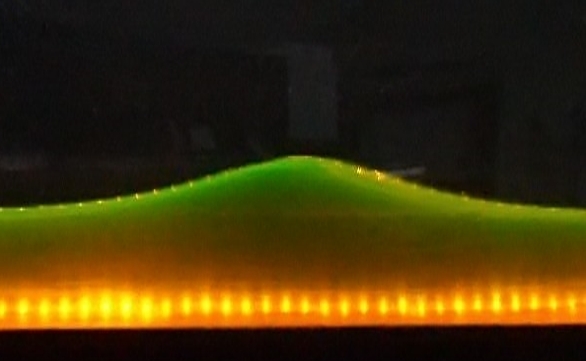50 years of solitons in fiber optics!

The soliton is a waveform with the rare particularity of being able to propagate without deformation, and this despite a priori destructive effects such as dispersion and non-linearity. These strange waves were highlighted for the first time in 1834 in Scotland in a canal: the engineer John Scott Russel was then taken aback by a mysterious wave of high amplitude capable of traveling over several kilometers while remaining identical to itself. even. Such observations were reproduced in a Dijon reach of the Burgundy Canal by Henry Darcy and Henry Bazin in the middle of the 19th century before a mathematical treatment rigorously explained the origin of these waves as resulting from a perfect balance between dispersion and non-linearity.

Figure: Hydrodynamic soliton recreated in the channel of the Physics department of the University of Burgundy.

Figure: Optics & Photonics News cover, Optics Communications special issue and SFP General Congress.
The soliton has since been a major subject of study that has gone far beyond the field of hydraulics. It has thus been observed in different materials, in atomic or quantum physics, in power lines, in chains of mechanical oscillators, in DNA strands, in meteorology… and in optics! Indeed, with the advent of lasers capable of generating high amplitude light pulses, and following the development of optical fibers, researchers Fred Tappert and Akira Hasegawa numerically predicted the existence of solitons in optical fibers. That was 50 years ago and this concept opened the door to many innovations in optical telecommunications, in the field of ultrafast lasers, in the physical explanation of very powerful structures, in the development of supercontinuums or of high-precision frequency combs.
The study of solitons holds a very special place at the University of Burgundy with work carried out under the impetus of physicists such as Michel Remoissenet or Michel Peyrard. In 1998, Guy Millot created the Solitons Lasers and Optical Telecommunications team (now SAFIR Solitons, Lasers, Fibers and Infrared Photonics) in which both the technological applications and the most fundamental aspects of solitons are explored.
To commemorate these fifty years of the soliton in optical fibres, researchers from the SAFIR team in the photonics department, in collaboration with their colleague John M. Dudley from the FEMTO-ST laboratory, have undertaken various actions. Thus, a special issue of the journal Optics Communications has been launched where in particular A. Hasegawa does the honor of returning to the path that led him to solitons in fibers. A mini-symposium is also organized on this theme at the general congress of the French Physical Society held at the Cité des Sciences et de l’Industrie in Paris in July. Finally, the popular optical magazine Optics and Photonics News made its cover in its May issue on this anniversary.
- Futher information :
Fifty Years of Fiber Solitons, J.M. Dudley, C. Finot, G. Genty and R. Taylor, Optics and Photonics News, may 2023 (open access article link) - Contact : Christophe FINOT, christophe.finot@u-bourgogne.fr
- kc_data:
- a:8:{i:0;s:0:"";s:4:"mode";s:2:"kc";s:3:"css";s:0:"";s:9:"max_width";s:0:"";s:7:"classes";s:0:"";s:9:"thumbnail";s:0:"";s:9:"collapsed";s:0:"";s:9:"optimized";s:0:"";}
- kc_raw_content:
- [kc_row use_container="yes" _id="410089"][kc_column width="12/12" video_mute="no" _id="509748"][kc_spacing height="20" _id="881783"][kc_column_text _id="134678"]
The soliton is a waveform with the rare particularity of being able to propagate without deformation, and this despite a priori destructive effects such as dispersion and non-linearity. These strange waves were highlighted for the first time in 1834 in Scotland in a canal: the engineer John Scott Russel was then taken aback by a mysterious wave of high amplitude capable of traveling over several kilometers while remaining identical to itself. even. Such observations were reproduced in a Dijon reach of the Burgundy Canal by Henry Darcy and Henry Bazin in the middle of the 19th century before a mathematical treatment rigorously explained the origin of these waves as resulting from a perfect balance between dispersion and non-linearity.
[/kc_column_text][kc_spacing height="41px" _id="630037"][/kc_column][/kc_row][kc_row use_container="yes" _id="646439"][kc_column width="45%" _id="566513"][kc_single_image image_size="full" _id="220052" image_source="media_library" image="42482"][kc_spacing height="5px" _id="324250"][kc_column_text _id="626179"]Figure: Hydrodynamic soliton recreated in the channel of the Physics department of the University of Burgundy.
[/kc_column_text][kc_spacing height="30px" _id="544085"][kc_single_image image_size="full" _id="99098" image_source="media_library" image="42486"][kc_spacing height="5px" _id="854328"][kc_column_text _id="205804"]Figure: Optics & Photonics News cover, Optics Communications special issue and SFP General Congress.
[/kc_column_text][/kc_column][kc_column width="5%" _id="790727"][/kc_column][kc_column width="50%" _id="423561"][kc_column_text _id="916756"]The soliton has since been a major subject of study that has gone far beyond the field of hydraulics. It has thus been observed in different materials, in atomic or quantum physics, in power lines, in chains of mechanical oscillators, in DNA strands, in meteorology… and in optics! Indeed, with the advent of lasers capable of generating high amplitude light pulses, and following the development of optical fibers, researchers Fred Tappert and Akira Hasegawa numerically predicted the existence of solitons in optical fibers. That was 50 years ago and this concept opened the door to many innovations in optical telecommunications, in the field of ultrafast lasers, in the physical explanation of very powerful structures, in the development of supercontinuums or of high-precision frequency combs.
The study of solitons holds a very special place at the University of Burgundy with work carried out under the impetus of physicists such as Michel Remoissenet or Michel Peyrard. In 1998, Guy Millot created the Solitons Lasers and Optical Telecommunications team (now SAFIR Solitons, Lasers, Fibers and Infrared Photonics) in which both the technological applications and the most fundamental aspects of solitons are explored.
To commemorate these fifty years of the soliton in optical fibres, researchers from the SAFIR team in the photonics department, in collaboration with their colleague John M. Dudley from the FEMTO-ST laboratory, have undertaken various actions. Thus, a special issue of the journal Optics Communications has been launched where in particular A. Hasegawa does the honor of returning to the path that led him to solitons in fibers. A mini-symposium is also organized on this theme at the general congress of the French Physical Society held at the Cité des Sciences et de l'Industrie in Paris in July. Finally, the popular optical magazine Optics and Photonics News made its cover in its May issue on this anniversary.
[/kc_column_text][kc_spacing height="20" _id="651336"][kc_column_text _id="130789"]- Futher information :
Fifty Years of Fiber Solitons, J.M. Dudley, C. Finot, G. Genty and R. Taylor, Optics and Photonics News, may 2023 (open access article link) - Contact : Christophe FINOT, christophe.finot@u-bourgogne.fr
- Futher information :
